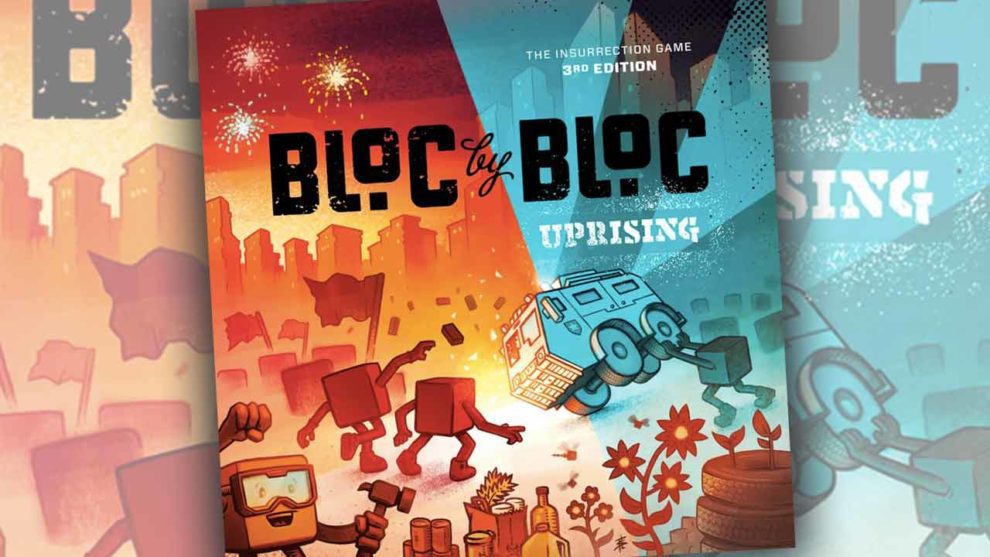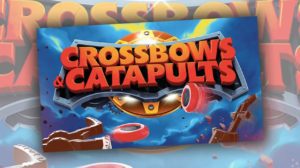My wife is the protester in our family.
She’s the one who took to the streets in her youth, making signs that scream of injustice, banding together with other movements to rise up against “the system.” No arrests yet, but at least she has been angry enough to take the time to raise her voice from time to time.
Me? I’ve always wanted to be that guy, but the couch is usually too comfortable on the day of that protest. There’s always an excuse, which in retrospect always saddens me a bit. Aren’t you riled up by what happened to [insert wronged community here]?
I am! But, not that much. As I’ve gotten older, the juices don’t flow like they once did. Kids show up, the 401(k) becomes the priority, and I’m already late for work.
Luckily, we have board games. And with a game like Bloc by Bloc: Uprising (2022, Out of Order Games) coming my way, I now have the chance to chuck a Molotov at police vans, or lead a mob of prisoners across the city in protest of poor living conditions. Uprising is a stab at a life of insurrection, for those of us who love the idea of a riot without having to actually start one.
The game succeeds at setting the stage and imposing a theme. Gameplay is something different.

Back, Back and Forth, Forth
One of my favorite songs from the 1980s, Cameo’s Back and Forth, came to mind often while playing games of Bloc by Bloc: Uprising. This is the third edition of the game, dating back to 2016’s Bloc by Bloc: The Insurrection Game.
In Uprising, players cooperate (or semi-cooperate, if you’d like) by taking on the role of various factions, ranging from students to workers to neighbors to prisoners. A 5×5 grid of District tiles make up the game’s board, laid out on a handsome mat included with each copy of the game. Some Districts are simply highways, while others are commercial, public, and state tiles representing areas that must be liberated by the players to advance the victory conditions.
Forming blocs of angry participants, each turn requires players to roll 3-5 dice to take actions based on the location of that player’s blocs. Before each player can take an action, 1-3 Police Ops cards dictate the movements of “The Man” as cops continuously encircle player blocs using an easy-to-administer series of AI rules.
Blocs are first considered by their main status: in a clash, or not in a clash. If you want to use any of your deployed blocs that are not in a clash, they can do things like move around the map, loot shopping centers, or build Occupations. Occupations (Assembly Halls and Mutual Aid Centers) help spread a faction’s influence while also generating more blocs or Loot cards, bonuses that level the fight against the police.
If your units are in a clash, actions become very limited. Blocs engaged on a space with police squads or vans can’t leave their tile. Next, they usually have to defeat a van if there is one on their space; if the factions are not able to defeat a van by the end of the round (all factions take a turn before the round is over), the van defeats all blocs and Occupations on that tile.
Thanks to the power of dice, factions can attack those police vans, or defeat police squads if they roll greater than or equal to the district’s difficulty. Easier said than done, factions are usually better off with Loot cards when starting a clash. Thanks to the way end-of-round cleanup happens, you’ll need a bit of luck to liberate a District, because the police get to move again before you can check liberation conditions on the map.
You’ll usually need some lucky dice rolls to take back your city. More often than not, you are in control of districts, then lose control because of the way cops move around the map. Even the game’s victory conditions can be undone by police movements later in the game. To win, each faction will need to place a Conditions token on revealed objective cards before a countdown timer reaches zero.
This turns Uprising into an interesting tug of war…at least, for the first hour.

What Works?
Uprising does a lot of things well. The rules are easy to parse. Teaching the mechanics is not difficult, and the player aid provides 80% of what everyone needs to play the game. Some of the production elements are subtle winks at the real-life status quo. For example, all of the cops are represented by white cubes, while all of the factions are presented by a diverse mix of color cubes. (I see you, design and production team!)
Executing the clean-up processes on each faction’s turn and knocking out the end-of-round requirements is not that much of a chore. After recently playing Frostpunk: The Board Game—an experience which has nine steps per round, EIGHT of which are maintenance—I really like how quickly Uprising walks players through the police movement steps.
A lot of the tactical strengths of Uprising also work well. In many ways, I felt like I was playing a Star Wars spinoff game as the Rebellion, trying to take out small Imperial outposts all over the game’s imaginary city. Lots of small, quick strikes work better in Uprising than trying to take on multiple police vans and large groups of police squads. It was fun to take down a solo police squad that was in my way with 2-3 blocs, playing a Loot card with an attack roll bonus to ensure that I came away victorious. Using these moves to set up future turns was occasionally satisfying.
Although I’m not sure umbrellas would really help me in a fight with the police, I liked many of the Loot cards even if they are just window dressing for the bonuses you’ll receive during play. Thematically, the game’s biggest faction win is the Students faction; their special power is that a single Student bloc can slip out of a clash with the police because, well, they are young, I guess?
I prefer Uprising most as a solo experience; in it, you simply play as two factions instead of just one. This furthers my thinking that Uprising would turn into a massive quarterbacking affair with a full complement of four players, at least in the cooperative format.
Uprising also includes a semi-cooperative mode where each player has a side agenda, but this also feels a bit off. I’m OK pretending that students would work with former prison inmates to liberate a city, even if that is a major stretch mentally. But then you are also saying that the students had other nefarious plans for what they would do if they could survive the experience?

What Doesn’t Work?
The main gameplay loop of Uprising is where I have an issue with the game. That loop is just not very interesting, and it is almost completely dependent on your dice rolls.
Players will spend a few rounds building up their blocs. More blocs equals more dice, so you need to find ways to grow your dice pool. The cops move every turn, so in a four-player game, they move four times before the end of the round, when they move a fifth time before end-of-round steps begin. If you are the fourth player that round, the downtime would be massive. (I did not play a four-player game for this review.)
When you do take a turn, you have the chance to move a couple of blocs around the city, loot some spaces, maybe take down a cop. Later, you’ll spend a shocking amount of time working with other players to meet a tile’s Liberation requirements, which is usually having 8-12 total blocs on a single tile with no cops and no vans on it. And that only happens if no other cops or vans move to that tile during the end-round clean-up.
I was surprised how many rounds of Uprising ended with blocs clearing a tile of cops, only to have a van and a couple of squads move onto it as the first step of cleanup (known as Sunrise in Uprising). Factions can’t take any actions during clean-up, so that means you’ll have to wait an entire additional round to try again, and knocking out police vans is really tough.
That loop becomes quite monotonous, and there will be turns where you are fighting a police van on a tile with a difficulty level of six and can’t hit it even once. (Vans take three successful hits to topple, and they all have to happen in the same round or the damage resets.) If you roll three dice on your turn as a faction, you can combine dice results to get what you need. But on the tile described in this example, if you roll a two, two, and a one, that total of five isn’t even useful to knock a police squad off the space, let alone damage a van.
At this point, Uprising doesn’t feel like an insurrection game. It just feels like, well, a game. Even though I want to put my fist in the air to rage against the machine while Public Enemy’s “Fight the Power” is playing in the background, I really just want to play something else.

The Politics of It
Uprising, then, is basically Risk, with a much more interesting premise. In many ways, it’s also like Pandemic, as you fight off problems in one location to only run to a different location and fight off the same problem.
You’ll be surprised how often you find yourself rolling dice and hoping for a miracle as your Neighbors faction tries to topple a police van before all of their blocs are removed from a tile. Or, in some games, you’ll be oddly shocked at how easy a game of Uprising is because the police or Conditions decks randomly moved cops out of the way for your merry band of inmates to liberate the Financial District.
I wish that Uprising had more ways to liberate its city through social pressure or political means, and not by throwing Molotovs (actually, Loot cards) at cops in riot gear. Hegemony: Lead Your Class to Victory nails that protester mindset in a much more thematic way than Uprising does, while providing gameplay that feels more appropriate to the setting.
Uprising is a decent exercise when you are able to regularly roll four or five dice and get the results you need to quickly move through the process of liberating districts, building Occupations on those liberated districts, and completing those Conditions cards quickly. A little drama is great, but too much drama just slows down the game to the point that games may bleed on and on without a significant boost in excitement.
I was really excited for this one, so part of my disappointment is married to my expectations. I’m glad games with this theme are out there, and now I want to find more games like it that provide more “wow” moments.











Add Comment